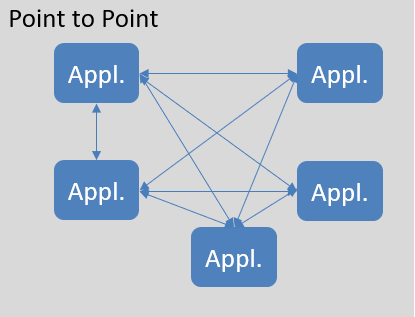Hi Guys,
This article will show you integration modes, what are “Point to Point”, “Hub & Spoke” and “Service Bus”. What is should be used for integration.
Simply conceptual of Integration is transfer data from system to system. Day by day, technology growing up and changed. Transforming data from system to system more complication and more systems, services invoke to integration landscape.
The big challenge for technical operation, how to make data consistency, stability, and immediately.
Diagram below will show you three main data transformation conceptual.
- Point to Point
- Hub and Spoke
- Enterprise Service Bus

Point to Point
Point to point data transfer is obsolete integration model. In this landscape, each application / Services connect to each other directly and independently.
Example: In your organization, you have Accounting, CRM, Point of Sales, inventory management, Reporting, etc.. systems. Each system will connect to each other to get master data / transaction data. Just imaging your organization had multi sub-division with different locations. The integration landscape will be complicated and hard to monitor data transferring.
The configuration from point to point will chaos, called “spaghetti” configuration.
Drawback
As i mentioned above, this model is obsoleted data transfer model. There are disadvantaged points you need to aware when you want to use:
- Multi-point Configuration complexity
- Distributed data transfer monitoring.
- Infrastructure change complexity
- Much more customizing when new data transfer protocol.
- Out of control since the number of connections grows to the square of number of systems.

Hub and Spoke
Hub and Spoke model, each point connect to other via central point (Hub). Data transfer between system to system through Hub application. The benefit of Hub model help reduce point to point connection.
Example: We have 10 points in our landscape, with Point to Point model system would require 45 routers. Hub require 9 routers only.
Benefits
- Reduce transfer routers with multi-point in landscape.
- Monitoring and administration.
Drawback
- It may be difficult to handle occasional periods of high demand between to spokes. As a result of this, route scheduling is complicated for the network operator, since scarce resources must be used carefully to avoid starving the hub and careful traffic analysis and precise timing are required to keep the hub operating efficiently.
- The hub constitutes a bottleneck with high demand data transfer.

Enterprise Service Bus
Enterprise service bus implements a communication system between system to system in a service-oriented architecture(SOA).
Benefits
- Route messages between services
- Monitor and control routing of message exchange between services.
- Control deployment and versioning of services.
- Reduce redundant services.
- Provide common services like error handling, data transform and mapping, messages and event queuing and sequencing.
- Protocol conversion and proper enforcing quality of services.

Thanks for reading,
Cuong Dang
2 comments